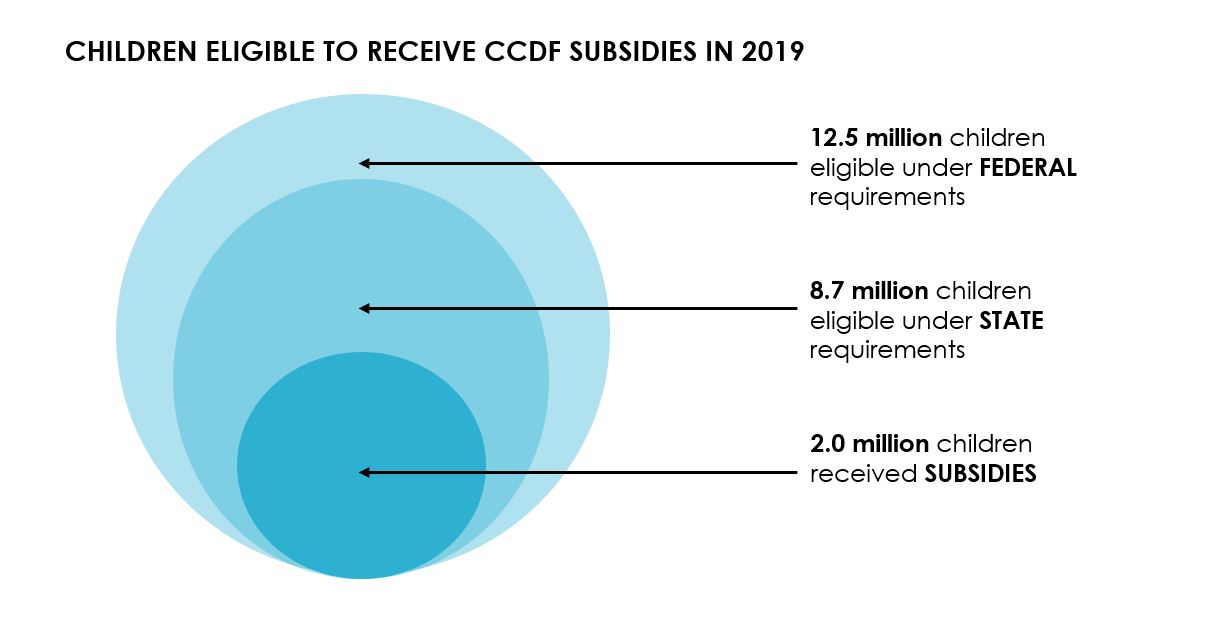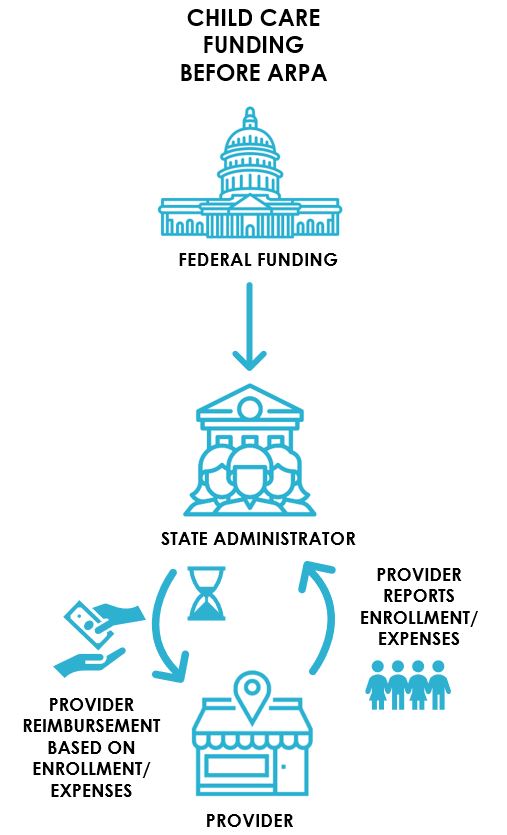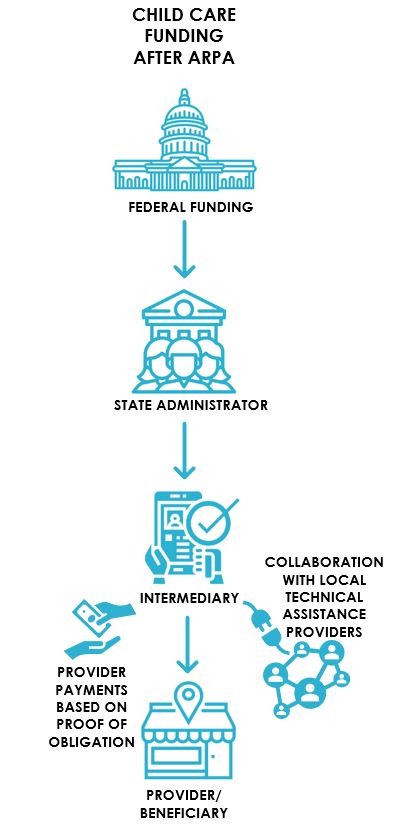To support the struggling child care sector during and after the pandemic, Congress dedicated billions in child care relief funding under the American Rescue Plan Act (ARPA). The LISC Child Care and Early Learning team explores how minor but important changes in the administration of ARPA funding directed to child care programs can streamline deployment and make federal fund distribution more equitable.
The Child Care and Development Fund (CCDF) is a federal and state partnership program that provides financial assistance to low-income families to access child care. Congress authorized the CCDF to streamline the “delivery and administration of child care programs at both the state and federal levels.” Administered by the Office of Child Care at the U.S. Department of Health and Human Services (HHS), the CCDF is supported by a combination of funding streams: discretionary Child Care and Development Block Grant (CCDBG) appropriations and mandatory funds from the Child Care Entitlement to States (CCES).
The CCDF funds child care by providing vouchers or certificates for eligible families seeking child care services and by reimbursing child care providers to reserve slots for eligible children, many under the age of six. Policymakers established the CCDF with the goal of maximizing state flexibility to design child care and early learning program eligibility requirements, licensing regulations, and quality standards. As a result, CCDF program policies, eligibility requirements, licensing regulations, and quality standards vary by state. For example, in 2019, 12.5 million children were considered eligible under the federal CCDF requirements but only 8.7 million children were considered eligible under state rules and just two million of those eligible children actually received CCDF subsidies.
Prior to the administration of ARPA resources some state administrative practices and threshold requirements created unintended hardships for child care providers. However, amid the COVID pandemic and in an effort to get urgently needed capital in the hands of families, workers, and businesses, changes to the way monies were distributed has had an important and positive impact on how providers are paid and how families can access quality care. It is a change worth safeguarding to reduce administrative burden and create systems with equitable access to funding opportunities.

The CCDF funds apportioned to reimburse providers are critical to supporting the nation’s fragile child care and early learning infrastructure. Historically, state CCDF provider reimbursement policies have been based on daily attendance. But reimbursing based on daily attendance is particularly problematic for providers who don’t have sufficient cash flow to support operating expenses like teacher salaries (and teachers need to be paid regardless of whether a student is absent for a period of time). In many states, provider reimbursement policies are difficult to navigate and generate barriers to accessing capital funds, which in turn affects the quantity and quality of child care.
LISC Highlight
Child Care providers, both for-profit and non-profit, can count on LISC for access to a range of capital products. Learn more about LISC's loan products and reach out to the local LISC office in your area for more information about unique opportunities that may be available to you.
The pandemic posed extreme challenges for the child care sector, and to prevent the entire industry from collapsing, Congress dedicated $15 billion in child care relief funding for the temporary expansion of the CCDF under the American Rescue Plan Act (ARPA). The funds were dispensed utilizing states’ existing, albeit imperfect, bureaucratic structures. In fact, the preexisting flaws in many states’ CCDF attendance-based provider repayment systems were exacerbated by the pandemic. As a result, several states, including California, Colorado, Massachusetts, Michigan, New Jersey, and Nevada, responded by using their ARPA dollars to pay providers based on enrollment rather than attendance. This simple change is already demonstrating significant improvements for providers and families: reimbursing providers based on enrollment reduces revenue gaps for providers, helps to stabilize their operations and thereby expanding high-quality options for eligible families.
 |  |
ARPA’s child care relief funding also included $24 billion for stabilization grants. In an effort to increase the supply of child care programs most effectively, especially for historically underserved populations, several state and territory lead agencies elected to contract with intermediaries. These intermediaries are already familiar with grant structures, leveraging tactics, licensing regulations, quality standards, local markets, and providers ensuring the proficient apportionment of federal resources. Furthermore, ARPA’s stabilization grant guidelines instructed lead agencies and intermediaries to evaluate subgrant allocations to eligible child care programs based on enrollment and/or licensed capacity rather than attendance. Serving as deployment partners, intermediaries like LISC are well positioned to equitably allocate stabilization grant funds, according to federal guidance, through implementation, deployment, monitoring, and ongoing compliance. LISC serves as an intermediary reaching providers in historically underserved communities, improving facility conditions for the workforce, and increasing access to quality programs.
Arizona
In December of 2022, LISC Phoenix opened up applications for the Arizona Child Care Infrastructure Grant Project through collaborative partnerships with First Things First and the Arizona Department of Economic Security Division of Child Care. This time-limited $65 million project was made possible by an appropriation from ARPA coupling grants for infrastructure improvements with technical assistance activities and business supports to address critical gaps in quality child care supply. This grant opportunity came about as the culmination of a Child Care and Early Learning in Arizona Landscape Analysis conducted by LISC Phoenix and supported by Vanguard Strong Start for Kids. Read the executive summary or full report here.
Another ARPA authorized program, U.S. Department of Treasury administered Coronavirus State and Local Fiscal Recovery Funds (SLFRF), is providing relief dollars to address the unique child care needs of local communities across the country. To accomplish this, SLFRF permitted uses cover replacing lost public sector revenue, responding to the far-reaching public health and negative economic impacts of the pandemic, and providing premium payments and other benefits to support essential workers, particularly lower-income frontline workers. Under Treasury’s SLFRF guidelines prime recipients like state, local, territorial, and Tribal governments are authorized to distribute subgrants directly to subrecipients. Subrecipients are subject to the same terms and conditions as the prime recipients, including program compliance requirements. Subrecipients can then award grant funding directly to new and existing child care and early learning providers and programs. As a subrecipient, LISC is assisting prime recipients establish and administer grant-making structures to support child care operators and their facility projects and achieve one or more of the following: increasing the number of infant and toddler child care slots, improving the quality of child care slots, addressing child care deserts, and prioritizing the needs of families of low and moderate income and underserved communities.
A further important distinction was made as part of the administration of SLRF funding – the designation of child care operators as “beneficiaries” of this Federal award program. The beneficiary status is intended to reduce administrative burden and improve access to capital, particularly for those who had historically experienced barriers to accessing Federal dollars. Similar to the changes made under CCDF to pay providers based upon enrollment as opposed to attendance, the beneficiary status enables subrecipients to award funds to child care providers based upon proof of obligation as opposed to proof of expenditure (i.e. reimbursement). Operating on a reimbursement basis – where qualifying projects and child care operators are required to expend their own funds first to access funding - is particularly problematic in the child care field, as many operators do not have sufficient cash flow to front project expenses. In particular, smaller-scale operations like home-based child care and small independent centers overwhelming serve low-wealth communities of color are the organizations most often operating at razor-thin profit margins. Reimbursement structures have long created barriers to accessing capital funds, and instituted processes that are difficult to navigate. This seemingly minimal change supports central program goals of equitable resource allocation, while reducing administrative burden, and enables effective and quick capital deployment to those who need it most.
Rhode Island
In Rhode Island, where LISC has operated the Rhode Island Child Care and Early Learning Facilities Fund for more than two decades, a 2019 comprehensive Early Learning Facilities Assessment laid the foundation for a groundbreaking ballot referendum to introduce a general obligation bond to support the development and improvement of early learning spaces across the state. The ballot measure received overwhelming voter support and LISC is currently administering these essential dollars through the Early Child Care and Education Capital Fund. The 2023 Providence Early Learning Infrastructure Support Program is an SLFRF- and City-funded program being administered by LISC in partnership with the City of Providence. By designating home based, family child care provider (FCC) grant recipients as beneficiaries, LISC Rhode Island was able to exponentially grow the number of FCCs supported through this program.
Connecticut
In Connecticut, LISC is establishing and administering grant-making structures rooted in equitable distribution of funding to support child care operators and their facility projects. LISC is carrying out a $15 million ARPA-funded program on behalf of the State whereby child care operators are designated as eligible beneficiaries to receive funds to add and/or improve quality early learning spaces across the geography. Outreach and collaboration with a number of on the ground technical assistance providers ensures program grantees compliance with licensing requirements and encourages participation in quality improvement and business and organizational capacity building. The program seeks to help all applicants navigate the local child care system and connect them to resources so they can stabilize operations and grow their impact.
Permitting intermediaries and subrecipients to award funds to providers and programs streamlines the equitable distribution of federal funds. Intermediaries and subrecipients like LISC are already equipped to leverage and rapidly deploy dollars, and have extensive experience and technical knowledge about federal, state, and local funding. Moreover, they’ve fostered the organizational capabilities and regional connections required to support beneficiaries and safeguard compliance. Simply put, intermediaries and subrecipients like LISC have proven to be more cost effective and efficient at administrating child care sector funds than traditional bureaucratic establishments like lead agencies and prime recipients. For those reasons, the federal government should normalize the utilization of intermediaries and retain the use of subrecipient and beneficiary designations as a consistent fund deployment strategy across all programs designed to reach child care operators. It is a proven way to sustain fair and effective child care relief funding and ensure future progress.
About the Authors
 Bevin Parker-Cerkez (she/her/hers), Program Director, Child Care and Early Learning
Bevin Parker-Cerkez (she/her/hers), Program Director, Child Care and Early Learning
Bevin joined LISC in 2020 to support the growing work in LISC’s child care investment portfolio and currently leads the team in its work to build a national platform, deliver technical support, and assemble flexible capital. Prior to LISC, she spent a decade at Reinvestment Fund, a mid-sized CDFI, where she raised over $45 million in grants and program-related investments for the child care sector. There, she was also responsible for sourcing capital and implementing multiple COVID-19 response funds and is co-author of the “Home-Based Child Care Emergency Fund Toolkit”. Bevin frequently presents on and participates in research work focused on facilities financing and the integration of child care and community development. She is an active member of several networks and boards.
 Maggie-Leigh O’Neill [she/her/hers], Policy Consultant
Maggie-Leigh O’Neill [she/her/hers], Policy Consultant
Maggie began working with LISC’s National Child Care and Early Learning Team in July 2021. She supports the team with research projects, policy reports, and presentations related to early child care and education policy. Maggie holds an undergraduate degree in business administration from Ithaca College and a master’s degree in public policy from the Edward J. Bloustein School of Planning and Public Policy where she received the Public Policy Outstanding Student Service Award. Prior to graduate school, Maggie spent a decade specializing in municipal policies and procedures at Architecture/Master Planning and Engineering firms. She is committed to the creation, implementation and enforcement of equitable and inclusive policies and programs.
 Nicole Barcliff, Senior Policy Director
Nicole Barcliff, Senior Policy Director
With two decades of public policy experience, Nicole Elizabeth Barcliff joined LISC in November 2012. As a Senior Policy Director, she advocates for federal policies that support LISC’s mission to forge resilient and inclusive communities of opportunity across America – great places to live, work, visit, do business and raise families. Nicole works closely with LISC national programs, LISC local offices, and a broad cross-sector of organizations to develop legislation and implement policy advocacy agendas that promote access to equitable opportunity in local communities. Her priority policy areas include safety and justice, health, and child care and early learning. Prior to joining LISC, Nicole held various positions that helped shape her federal policy expertise, including serving as Legislative Director for a member of Congress in the U.S. House of Representatives, Vice President for Education Affairs at the Motion Picture Association of America (MPAA), and Senior Associate for Government Relations at the Pew Charitable Trusts.